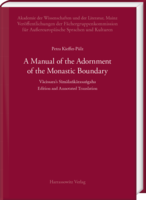|
weitere Titel zum Thema:
Download:
Bitte beachten Sie: Mit digitalen Produkten in Ihrem Warenkorb
wird die Bezahlung nur per PayPal möglich. Der Download dieser Produkte wird bereitgestellt, wenn die Bezahlung bestätigt ist. The Sīmālaṅkārasaṅgaha, “A Manual of the Adornment of the Monastic Boundary”, is a verse text of 99 stanzas written in the Middle Indic language Pāli around the beginning of the 13th century by the Sinhalese monk Vācissara. It deals with Buddhist monastic boundaries (sīmā) which define the areas within which Buddhist communities of monks or nuns meet to carry out legal acts such as ordinations. Any ambiguity of a monastic boundary can cause the invalidity of the legal acts carried out within it. The Sīmālaṅkārasaṅgaha focuses on a difference in interpretation regarding whether or not connections between certain types of monastic boundaries, namely between a ‘determined boundary’ and a ‘village boundary’, lead to a confusion of the areas, and thus render the legal acts carried out within the ‘determined boundary’ invalid. Vācissara defends the Sinhalese approach that says that there is a confusion against the South Indian Coḷiya approach that says there is not. This is the only text that throws light on the relation of these two traditions and their dispute about monastic boundaries from the Sinhalese perspective.
The monograph contains an edition, the first translation into a Western language (annotated), as well as an investigation into the text, the author, the meter, the content, its position in Pāli literature, and its reception. |
|||||||||||||||||||||||||||||||||||||||






